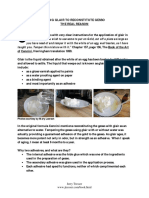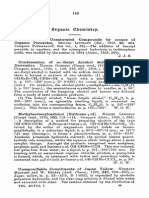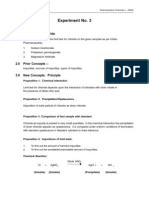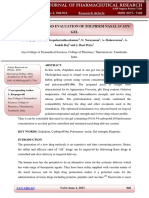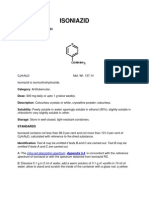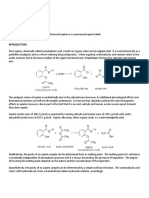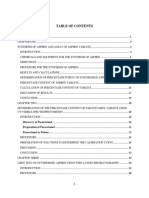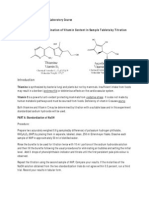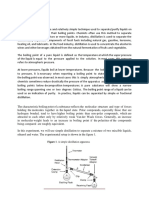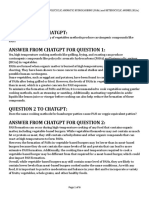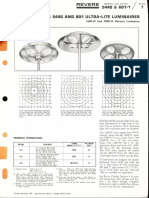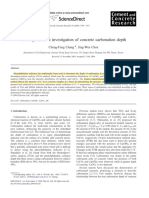Isotonic Calculation
Isotonic Calculation
Uploaded by
Jhen JustoCopyright:
Available Formats
Isotonic Calculation
Isotonic Calculation
Uploaded by
Jhen JustoCopyright
Available Formats
Share this document
Read this document in other languages
Did you find this document useful?
Is this content inappropriate?
Copyright:
Available Formats
Isotonic Calculation
Isotonic Calculation
Uploaded by
Jhen JustoCopyright:
Available Formats
Isotonic calculation Document Transcript
1. CALCULATION FOR SOLUTION ISOTONIC WITH BLOOD AND TEARSSome of the many ways; 1. Freezing point depression method 2. NaCl equivalent method 3. White Vincent method 4. Sprowl method 5. Molecules concentration method 6. Graphical method on vapor pressure and freezing point determination 1. FREEZING POINT DEPRESSION METHOD The plasma and blood freezing point temperature = -0.52C The dissolved substances in plasma or tear depress the solution freezing point below 0.52C Any solution that freeze at T=-0.52C is isotonic with blood and tear weight of substance that need to be adjusted to make it hypotonic given by the following formula; 0.52 = Where, W=the weight, in g, of the added substance in 100ml of the final solution a =the depression of the freezing point of water produced by the medicament already in the solution (calculated by multiplying the value for b for the medicament by the strength of the solution express as % w/v) b=the depression of freezing of water produced by 1 per cent w/v of the added substance ~mlk~ | 1Freezing Point Depression Method 2. Example 1.1 Rx Tf 1% NaCl 900mg 0.576 Dextrose q.s (20.5g) 0.101 Ft. isotonic soulution500ml Or; 0.9% = Solution; 500 100 . . . ( . ) = 0.18% = = . = 4.12 100 For 500ml; 500 = (4.12 ) 100 = 20.6Example 1.2 Rx Ephedrine HCl 1g Chlorobutol 0.5g NaCl (1.4g) q.s Distilled water q.s ad 200ml Solution; 0.52 0.52 [(0.5 0.165) (0.25 0.138)] = = 0.576 = 0.7 100 200 ; 200 = (0.7 ) 100 = 1.4 ~mlk~ | 2Freezing Point Depression Method 3. EXercise 1.3Prepare 500ml NaHCO3 (T.f 1%=0.38) so that when it is dilute with the same amount of water, it wouldbe isotonic.Solution; Rx T.f 1% NaHCO3 Xg(13.7) 0.38 Water qs ad 500mlThe solution is hypertonic When diluted NaHCO3 Xg Water qs ad 1000mlThis solution is isotonic 0.52 0.52 0 = = = 1.37 0.38NaHCO3 required to make the solution isotonic upon dilution is;1.37 =100 10001.37 X 10 = 13.7g (to be dissolved to 500ml solution) ~mlk~ | 3Freezing Point Depression Method 4. 2. NaCl EQUIVALENT METHOD (E) Based on the factor called the sodium chloride equivalent which can be used to convert a specified concentration of medicament to the concentration of medicament to the concentration of sodium chloride that will produce the same osmotic effect. Standard 0.9 % w/v NaCl at isotonic Method to calculate % at isotonic, Tf 1% =0.576 ~ NaCl 0.52 0.52 0 = = = 0.9 0.9% 0.576 Known as normal saline Sodium chloride equivalents (E1%) can be calculated from the following formula; ( , . 927) = 0.576 ( )Formula & Method 1 Look up in the table the sodium chloride equivalent for the srenght of solution nearest to the strenght = 0.9% - ([E1%X %w/v] + .) of medicament in the preparation. 2 Multiply this by the strenght of the medicament. 3 substract the result from 0.9 per cent; the difference is strenght of sodium chloride necessary to adjust the solution to iso-osmoticity. ~mlk~ | 4 aCl Equivalent Method
5. Example 2.1 Tf 1% ascorbic acid =0.105C Tf 1% NaCl = 0.576CWhat is the E for 1% ascorbic acid?Solution . E 1% ascorbic acid= . = 0.18Example 2.2 Rx NaCl 0.2%w/v Dextrose q.s Ft. isotonic solution 500mlSolution; Tf 1% NaCl = 0.576C Tf 1% dextrose = 0.101 C . For dextrose 1 % (E1%) = . = 0.18Conclusion 1% dextrose has osmotic pressure equals to 0.18% NaClNaCl in the solution = 0.2 %Remaining amount of NaCl to be added for isotonic 0.9% - 0.2% =0.7%1% dextrose equivalent to 0.18% NaCl Convert amount of NaCl required% dextrose equivalent to 0.7% NaCl to amount of dextrose required (0.7%)(1%)= = 3.89% 0.18%For 500ml;3.89 =100 500 = 19.45 g ~mlk~ | 5 aCl Equivalent Method 6. Example 2.3 Rx E 1% Ephedrine HC 1g 0.3 Chlorobutol 0.5g 0.24 NaCl q.s Distilled water 200ml isotonic Solution; For ephedrine HCl 100 % 0.3 = 0.15% . For chlorobutol 100 % 0.24 = 0.06% Amount of NaCl for isotonic; 0.9% - (0.15% + 0.06%) = 0.69% So for 200ml.= 1.38 Example 2.4 Rx E 1% Let adjust isotonicity using KCl instead Ephedrine HCl 1g 0.3 of NaCl Chlorobutol 0.5g 0.24 KCl q.s 0.4 Distilled water 200ml isotonic Solution; 1% KCl equivalent to 0.4% NaCl Convert amount of NaCl required to % 0.69% NaCl (refer to example 3) amount of KCl required 0.69 = = 1.725% 0.4 So for 200ml ..= 3.45g KCl ~mlk~ | 6 aCl Equivalent Method 7. Example 2.5 Calculate the percentage of sodium chloride required to render a 0.5 per cent solution of potassium chloride iso-osmotic with blood plasma. Solution Sodium chloride equivalent of 0.5 per cent potassium chloride = 0.76 Percentage of sodium chloride for adjustment = 0.9 (0.5 0.76) = 0.9 0.38 = 0.52 Example 2.6 Calculate the percentage of anhydrous dextrose required to render a 1 per cent solution of ephedrine hydrochloride iso-osmotic with body fluid. Percentage of sodium chloride for adjustment = 0.9 (1 0.3) = 0.6 Equivalent percentage of anhydrous dextrose = 0.6/0.18 = 3.33 Example 2.7 Select a suitable substance for an eye lotion 0.5 per cent of silver nitrate and calculate the percentage required to render the lotion iso-osmotic with lachrymal secretion. Sodium chloride is unsuitable because silver nitrate is incompatible with chloride. Potassium nitrate will be used Sodium chloride equivalent of 0.5 per cent silver nitrate = 0.33 = 0.9 (0.5 0.33) = 0.9 0.165 = 0.753 . Equivalent percentage of potassium nitrate = = 1.3 . ~mlk~ | 7aCl Equivalent Method 8. 3. WHITE VINCENT METHOD Principle: A Isotonic solution + B isotonic solution = C isotonic solutionThis method involves the addition of water to medicament to obtain an isotonic solution. Thisfollowed by the addition of isotonic buffer solution or preservatives isotonic solution to the requiredvolume. V = W X E1% X 111.1Where;V= V (ml) of isotonic solution that could be obtain in wg of drug in water (the amount of water to addedto form isotonic solution)W= amount of drug in the formulaE1%=NaCl equivalent of the drug111.1= constant that could be find from volume for 1% isotonic NaCl 0.9% NaCl 1% NaCl 0.9g NaCl 100 ml 1 g NaCl 111.1 ml ~mlk~ | 8White Vincent & Sprowl
Method
9. Example 3.1 Rx E 1% Ephedrine HCl 1g 0.3 Chlorobutol 0.5g 0.24 NaCl q.s Distilled water 200ml isotonicSolution; This solution is isotonic (A)For ephedrine HCl, V=1 X 0.3 X 111.1 = 33.33ml (final volume) So the overallFor chlorobutol, V=0.5 X 0.24 X 111.1 = 13.33ml (final volume) This solution is isotonic (B) solution is isotonic200ml (33.33 + 13.33) ml = 153.34ml Amount of NaCl required to adjust 153.34ml to isotonic; This solution is isotonic (C) 0.9= 153.34 = 1.38 100 4. SPROWL METHOD Using white Vincent method but w is set to constant, 0.3 V = W X E1% X 111.1 or V = 33.33E1% ~mlk~ | 9White Vincent & Sprowl Method 10. 5. MILIEQUIVALENT (mEq) Definition; the gram equivalent weight of an ion is the ionic weight (the sum of atomic weights of the element in an ion) in gram divided by the valence of that ion. A mililequivalent is one thousandth part of the gram equivalent weight, the same figure expressed in milligram. Table 5.1 makes this clear Gram equivalent weight Ion Ionic weight Weight of 1mEq (mg) ( ) Sodium Na+ 23 23 23 Potassium K+ 39.1 39 39.1 Calcium Ca2+ 40 20 20 Chloride Cl 35.5 35.5 35.5 Bicarbonate HCO3 61 61 61 Phosphate HPO4 96 48 48 Gram equivalent weight i) For ion; = Example 1 Eq sodium 23/1 = 23g 1Eq chloride 35.5/1 =35.5 The weight of a salt containing 1mEq of a particular ion is obtained by dividing the molecular weight of the salt by the valency of that ion multiply by the number of such ion in the molecules , , 1 = ~mlk~ | 10Miliequivalent (mEq) 11. Table 5.2 makes this clear Weight of salt M. of Valency of Number of containing 1mEq Ion Salt used the salt the ion ion in salt of the ion Na+ Sodium chloride 58.5 1 1 58.5mg Na+ Sodium phosphate 358 1 2 179.0mg Ca2+ Calcium chloride 147 2 1 73.5mg Cl- Calcium chloride 147 1 2 73.5mg ( N.B. the water of crystallization must not be ignored) ii) For salt; = Example (monovalent) 1 Eq 58.5/1= 58.5g Example (not monovalent) 1Eq CaCl2.H2O 147/2 =73.5Miliequivalent (mEq) 1/1000 Gram Eq weightExample1mEq sodium 23mg1mEq chloride 35.5g1mEq NaCl 58.5 mg1mEq CaCl2.H2O 73.5 mg ~mlk~ | 11Miliequivalent (mEq) 12. Conversion Equations I. To convert mEq/litre to mg/litre; II. To convert mEq/litre to g/litre; 1000 III. To convert mEq/litre to %w/v; 10000 The BPC includes table showing the weight s of salt that contain 1 mEq of specified ion; Mg of salt containing 1 Ion Miliequivalent (mEq) mg Salt mEq of specified ion Na+ 23.0 Sodium chloride 58.5 Sodium bicarbonate 84 K+ 39.1 Potassium chloride 74.5 Ca2+ 20.0 Calcium chloride 73.5 Mg2+ 12.5 Magnesium sulphate 123 Magnesium chloride 101.5 Cl- 35.5 Sodium chloride 58.5 HCO3- 61.0 Sodium bicarbonate 84 HPO4- 48 Sodium phosphate 179 ~mlk~ | 12Miliequivalent (mEq) 13. Example 5.1 Calculate the quantities of salt required for the following electrolyte solution; Sodium ion 20 mEq Potassium ion 30 mEq Magnesium ion 5 mEq Phosphate ion (HPO4-) 10 mEq Chloride ion 45 mEq Water for injection, to
1 litre From table 5.3:- 1 mEq of both potassium and chloride ion are contained in 74.5 mg of potassium chloride. 1 mEq of both sodium and phosphate ion are contained in 179 mg of sodium phosphate. 1 mEq of both magnesium and chloride ion are contained in 101.5 mg of magnesium chloride. 1 mEq of both sodium and chloride ion are contained in 58.5 mg of sodium chloride. Therefore; 30 mEq of potassium ion is provided by 30 X 74.5 mg of potassium chloride which will also supply 30 mEq of chloride ion. 10 mEq of phosphate ion is provided by 10 X 179 mg of sodium phosphate which will also supply 10 mEq of sodium ion. 5 mEq of magnesium ion is provided by 5 X 101.5 mg of magnesium chloride which will also supply 5 mEq of chloride ion. There remains a deficiency of 10mEq of each sodium and chloride ions which cn be provided by 10 X 58.5 mg of sodium chloride. The formula becomes; ~mlk~ | 13Miliequivalent (mEq)
14. mg g mEq K+ Na+ Mg2+ Cl- HPO4- 1000 Potassium chloride 74.5 X 30 2.235 30 30 Sodium phosphate 179.0 X 10 1.790 10 10 Magnesium chloride 101.5 X 5 0.508 5 5 Sodium chloride 58.5 X 10 0.585 10 10 Water for injection, to 1 litre to 1 litre 30 20 5 45 10 55 55 The fact that cation and anion balance confirm that the formula has been worked out correctly Example 5.2 Express the following formula as percentage w/v. Sodium ion 147 mEq Potassium -ion 4 mEq Calcium ion 4 mEq Chloride ion 155 mEq Water for Injections, to 1 liter. From Table 20.6 and the appropriate conversion equation, the required percentages are Sodium Chloride 5.85 X 147 10 000 = 0.860% W/v Potassium Chloride 74.5 X 4 10 000 = 0.030% w/v Calcium Chloride 73.5 X 4 10 000 = 0.029% w/v Water for injections, to 1 liter ~mlk~ | 14Miliequivalent (mEq) 15. Example 5.3 Prepare 500 ml of an Intravenous solution containing 70 mEq of sodium, 2 mEq of potassium, 4 mEq of calcium and 76 mEq of chloride. The number of milligrams of the various chlorides which contain I mEq of the required ions is obtained from Table 20.6 and the formula becomes Sodium Chloride 70 X 58.5 1000 = 4.0Q5 g Potassium Chloride 2 X 74.5 1000 = 0.149 g Calcium Chloride 4 X 73.5 1000 = 0.294 g Water for Injections, to 500 ml It is not unusual for students to miscalculate the amounts for this type of formula due to failing to appreciate that mEq is a unit of weight and not an abbreviation for mEq per litre. This leads to an incorrect halving of the final quantities in the above example. Example 5.4 Express 0.9 per cent sodium chloride solution to mililequivalent per litre. 0.9 10000 = 154 / 58.5 To Convert Percentage w/v to mEq The number of grams (C) per 100 milliliters is converted to mg/liter by multiplying by 10 000. This, divided by the weight (W) in mg of salt containing 1mEq, will give the number of mEq/liter. 10000 = / ~mlk~ | 15Miliequivalent (mEq) 16. Adjustment to Iso-osmoticity with Blood Plasma Based on Miliequivalent The equation used is:- = 310 Where; a = number of mililequivalent per liter of medicament present and b = number of mililequivalent per liter of adjusting substance required Example 5.5 Calculate the amount of sodium chloride required to adjust a solution containing 40 mEq of each potassium and chloride ion to isoosmoticity with blood plasma. A solution containing 40 mEq of chloride ion
provide a total of 80 mEq of anion and cation. = 310 80 = 230 230 mEq will be provided by 115 mEq of sodium ions and 115 mEq chloride ions. The formula of the solution will be:- Potassium chloride 74.5 mg X 40 = 2.98 g Sodium chloride 58.5 mg X 115 = 6.73 g Water for injection, to 1 litre ~mlk~ | 16Miliequivalent (mEq)
17. 6. MILIMOLES In the SI, the unit for chemical quantity is mole and the term equivalent and mililequivalent becomes absolute. Consequently the method of expressing the composition of body and infusion fluid is changing from the mililequivalent to mole notation. By analogy with atoms and molecules, a mole of an ion is its ionic weight in grams but the number of moles of each of the ions of a salt in solution depends on the number of each ion in the molecule of the salt. It follows that the quantity of salt, in mg, containing 1 mmol of a particular ion can be found by dividing the molecular weight of the salt by the number of that ion contained in the salt. For example Salt Ion Quantity of salt (In mg) containing 1mmol NaCl Na+ M.Wt /1 = 58.5 CI- M.Wt / 1 = 58.5 CaCl2 Ca2+ M.Wt / 1 = 147 Cl- M.Wt /2 = 73.5 Na2HPO4 Na+ M.Wt /2 = 179 HP042- M.Wt /1 = 258 NaH2PO4 Na+ M.Wt /1 = 156 H2P04- M.Wt /1 = 156 Conversion Equations To convert quantities expressed in mmol per litre into weighable amounts. The following formulae may be used:- = = 1000 = 10000 Where W is the number of mg of salt containing 1 mmol of the required ion and M is the number of mmol per litre ~mlk~ | 17Milimole(mmol) 18. Example 6.1 Calculate the quantities of salts required for the following electrolyte solution. Sodium 60 mmol Potassium 5 mmol Magnesium 4 mmol Calcium 4mmol Chloride 81 mmol Water for injection, to 1 litre From Table 20.8 5 mmol of potassium ion is provided by 5 x 745 mg of potassium chloride which also provides 5 mmol of chloride ion. 4 mmol of magnesium ion is provided by 4 x 203 mg of magnesium chloride which also provides 2 x 4 mmol = 8 mmol of chloride ion, since there are two chloride ions in the molecule. 4 mmol of calcium ion are provided by 4 x 147 mg of calcium chloride which, like magnesium chloride, also provides 8 mmol of chloride ion. 60 mmol of sodium ion is provided by 60 x 58.5 mg of sodium chloride which provides a further 60 mmol of chloride. The formula becomes mmol WXM K+ Mg2+ Ca2+ Na+ ClPotassium chloride 5 x 74.5 = 0.373 g 5 5 Magnesium chloride 4 x 203 = 0.812 g 4 8 Calcium chloride 4 x 147 = 0.588 g 4 8 Sodium chloride 60 x 58.5 = 3.510 g 60 60 Water for injection, to 1 litre 73 31Although there appears to be inequality between the anions and cations, the charges are equallybalanced. ~mlk~ | 18Milimole(mmol) 19. Example 6.2 Calculate the number of millimoles of (a) dextrose and (b) sodium ions in 1 litre of Sodium Chloride and Dextrose Injection containing 4.3 per cent w/v of anhydrous dextrose and 0.18 per cent w/v of sodium chloride. Use the conversion equation = 10000 10000 = a) For dextrose Since dextrose is non-electrolyte, W = M.Wt Hence, 4.3 10000 = = 239 180.2 b) For sodium chloride 0.18 10000 = = 31 58.5 Since 1 mmol sodium chloride provides 1 mmol of sodium ion and 1 mmol of chloride ion, 1 litre of the solution
will contain 31 mmol of sodium ion (and 31 mmol of chloride ion ). Example 6.3 Calculate the number of milimoles of calcium and chloride ion in a litre of a 0.029 per cent solution of calcium chloride. 0,029 10000 = =2 147 But, each mole of calcium chloride provides 1 mol of calcium ions and 2 moles of chloride ions. Therefore, 1 litre of solution contains 2mmol of calcium ion and 4 mmol of chloride ion. ~mlk~ | 19Milimole(mmol)
20. ppm calculationEXamplePrepare 90ml NaF solution so that 5ml of the solution when diluted with water to 1cupfull(240ml), a3ppm solution obtained. Solution; 5ml solution 240ml final volume 90ml solution ? ml final volume (240 )(90 ) = = 4329 5 3g Na 1000000ml ? ml 4320ml ( )( ) = = 0.01296 0.01296mg needed 13mg NaFFormula NaF 13mg Distilled water q.s ad. 90ml ~mlk~ | 20 21. Calculation involving density factorEXampleGiven acetic acid BPC (33%w/w, d=1.04g/ml).What is the concentration of acetic acid in %w/wSolution; Acetic acid 33%w/w= 33g acetic acid in 100g solution d= 1.04g/ml ? w/v33g acetic acid 100g acid solution33g acetic acid ?ml solutionFrom density factor information; 104g acid 100ml acid solution 100g acid ?ml acid solution ( )( ) = = 96.15 ? gram acetic acid 100ml solution 33 = 100 = 34% 96.15 ~mlk~ | 21
In the general sense, two solutions are isotonic when they contain the same amounts of solutes, or dissolved substances, and therefore have the same osmotic pressure. As commonly used in the medical field, though, isotonic solutions are solutions which have the same concentration of solute as the cells in the human body. A cell placed in an isotonic solution will neither gain nor lose water. When two aqueous solutions of different concentrations or tonicities are separated by a semi-permeable membrane such as a cell wall, water will migrate from the less concentrated, or hypotonic, side to the more concentrated, or hypertonic, side in an attempt to bring both sides into equilibrium. This process is known as osmosis. The greater the difference in the two solutions' concentrations, the higher the osmotic pressure will be, and the quicker the osmotic transfer will be. If a living cell, which has a significant concentration of solutes, is placed in a dish of pure water, osmotic pressure will cause water from the dish to migrate into the cell, causing the cell to swell and possibly rupture. Conversely, if the cell is placed in a dish of water that contains solute in a higher concentration than the cell, water will flow from the cell out into the solution, causing the cell to shrivel and die. If the cell is placed in a dish of isotonic solution, there will be no net movement of water. http://www.wisegeek.com/what-are-isotonic-solutions.htm solution is a mixture of two or more substances. It has a solvent and a solute. Depending on the concentrations there are different kinds of solutions and their applications differ too. Isotonic solutions have the same salt concentration as the surrounding blood cells. So an isotonic solution will have no effect on the surrounding cells. The cells will not gain or
lose water if place in isotonic solution. The normal Saline solution which is 0.9% NaCl is isotonic with blood and is used in patients suffering from dehydration or if they can't take any liquids or food http://www.innovateus.net/health/what-isotonic-solution
What are Isotonic Solutions?
A solution which has the same concentration as present in the blood or cells of body is an Isotonic solution. Such cells neither absorb water nor lose any water molecule. Saline solution is a common example of isotonic solution. The tonicity or concentration is important in the medical field as it directly affects the living cells. When cells are placed in higher concentration solution, the cell is bound to swell and at one time ruptures letting the water molecule move to a solution with lower concentration. Similarly, when a living cell is placed in a solution with less concentration(hypertonic solution), it shrinks as the water molecule move out. This is the reason vaccines are administered in isotonic solutions to balance the fluid level. A person swimming in the sea for a long time can experience the effects of being in a hypertonic solutionand tend to loose lot of water which may even can result in death.
Isotonicity
There are four methods of adjusting isotonicity. For preparations meant for use as intra venous injections or for use in the eye or nasal tract or ear the liquid must be isotonic with the body fluids. This can be done by any one of four methods.
1. Cryoscopic Method :
Blood has a freezing point of 0.52 degreeC. So for any solution to be isotonic with blood, it must also have a depression of 0.52 0C. For a number of drugs the freezing point depression caused by a 1% solution is given in tables in literature. Steps: 1. We find out the freezing point depression caused by the given amount of the drug in the prescription in the given volume of water. 2. We subtract it from 0.52. 3. For the remaining depression in freezing point, we add sufficient sodium chloride, knowing that 1% sodium chloride has a freezing point lowering of 0.58 C.
2. Sodium Chloride Equivalent Method:
The sodium chloride equivalent is also known as tonicic equivalent. The sodium chloride equivalent of a drug is the amount of sodium chloride that is equivalent to (i.e., has the same osmotic effect as) 1 gram, or other weight unit, of the drug. The sodium chloride equivalent values of many drugs are
listed in tables. In this method we find out the E value of the drug; either from tables or from the formula, Liso E = 17 M Where E is sodium chloride equivalent value M is Molecular Weight L isois a factor which depends on ionic state of the salt. For Non electrolytes L iso is 1.9 Weak electrolytes L iso is 2.0 Divalent electrolytes L iso is 2.0 Uniuni valent electrolytes L iso is 3.4 Unidi valent electrolytes L iso is 4.3 Diuni valent electrolytes Lisois4.8 Unitrivalent electrolytes L iso is 5.2 Tri Univalent electrolytes L iso is 6.0 Tetraborate electrolytes L iso is 7.6 The steps are 1.We find the E value of the drug. 2.We multiplythe quantity of the drug with its E value. We get the weight (x ) that is equivalent to sodium chloride with respect to osmotic pressure. 3. Since, for every 100ml of solution, 0.9g of sodium chloride is required for isotonicity, we subtract the amount obtained in step 2 (x) from 0.9g; let this be y. 4. We add y of NaCl, to every 100ml of solution.
3.White Vincent Method :
In this method we add enough water to the drug to make the solution isotonic and then
we add an isotonic sodium chloride solution to it to bring up the volume to the required level. Steps involved are 1. Find the weight of the drug prescribed (w), the volume prescribed (v) and its sodium chloride equivalent value (E). 2. Multiply the weight (w) with the sodium chloride equivalent value (E). WXE=X So x is the weight of sodium chloride osmotically equivalent to the given weight W of the drug. 3.The volume V of isotonic solution that can be prepared from W g of drug is obtained by solving the equation 9.0 /100 =x/v V= ( Xx 100 )/0.9 V = X x 111.1 OrV = W x E x 111.1 = 4.So V is the volume of solution that is isotonic with blood. Dissolve Wg drug in Y ml of water. This solution is isotonic. 5.Now, make up the volume of this solution to the required volume with an isotonic solution, such as 0.9% sodium chloride solution.
II Sprowls Method :
In this method we make use of the V values which were defined and calculated for many drugs by Sprowls. Fixing the W as 0.3g for many drugs, and knowing their E values he calculated the V values for many drugs. Steps : 1.Find the V value from the table. V is the volume of solution that is isotonic with blood for 0.3. 2.For the prescribed amount of drug, calculate the volume. Suppose, prescribed weight is X g. For 0.3g, volume of water for isotonicity is v ml. For Xg, volume of water is ? V x ( X/0.3)=y
3.Now dissolve x g in y ml of water. 4.Make up this solution to the required volume with 0.9% sodium chloride solution.
Worked out Problems
1.How much sodium chloride is required to render 100ml of a 1% solution of apomorphine hydrochloride isotonic with blood serum? 1. From table, we find that a 1% solution of apomorphine hydrochloride causes a freezing point lowering of 0.08 C.
2. Depression in Freezing Point needed is 0.52 0 Depression in Freezing Point available 0.08 Further depression in Freezing Point required is0.44 1. 0.58C depression in Freezing Point is caused by 1% NaCl solution.
0.44C depression in Freezing Point is caused by ? NaCl solution ? 1 x0.44= 0.7586 or 0.76% 0.58 So 0.76 g of Nacl in 100 ml will give a lowering in Freezing Point of 0.44. So to make the required drug solution isotonic, we dissolve 1g of apomorphine hydrochloride and 0.76 g of sodium chloride in 100ml of water. Method 2 : 1. The E value of the drug is 0.14 2. 1 x 0.14 = 0.14g This is the amount of sodium chloride equivalent to 1g of apomorphine hydrochloride 1. 0.9 0.14 = 0.76 g. 2. Dissolve 1g of apomorphine hydrochloride and 0.76 g of sodium chloride in 100ml of water. Method 3 : 1. Weight of drug = 1g
Volume of solution = 100ml Sodium Chloride Equivalent E = 0.14 1. W x E = X 1 x 0.14 = 0.14 1. V = X x 111.1 = 0.14 x 111.1 = 15.55 ml 1. Dissolve 1g of apomorphone hydrocloride in 15.5 ml of water and make up this solution to 100ml with 0.9% sodium chloride solution. Method 4 : 1. The V value of apomorphine hydrochloride is 4.7. This is the volume of water required for 0.3g of drug for isotonicity. 2. Y = V Xx/0.3= 4.7 x1/0.3 = 15.66 3. Dissolve 1g of drug in 15.6 ml of water and make up the solution to 100ml with 0.9% sodium chloride solution. http://www.pharmainfo.net/pharma-student-magazine/pharmaceutical-calculations-0
You might also like
- Habibi Et Al 2024 Teaching Kinetics of The Traffic Light ReactionDocument8 pagesHabibi Et Al 2024 Teaching Kinetics of The Traffic Light Reactionvenkatesh.pranauvNo ratings yet
- Aspirin ExperimentDocument7 pagesAspirin ExperimentTrương Thị Bích LiễuNo ratings yet
- Determination of Ascorbic Acid by Titration Method PDFDocument1 pageDetermination of Ascorbic Acid by Titration Method PDFanthorNo ratings yet
- BromatometryDocument1 pageBromatometryinfinity GOD GamersNo ratings yet
- Practical Handbook OnDocument47 pagesPractical Handbook OnSleepyHead ˋωˊ100% (1)
- Fsra 5 Step Checklist PDFDocument1 pageFsra 5 Step Checklist PDFMaria Lisdiana100% (1)
- Analysis of Azeotropic Distillation Using CyclohexaneDocument8 pagesAnalysis of Azeotropic Distillation Using CyclohexaneJose SalgadoNo ratings yet
- Cennini The Use of GlairDocument4 pagesCennini The Use of GlairAnonymous Y2qwEuA100% (2)
- Chapter 17Document12 pagesChapter 17Michelle HsiehNo ratings yet
- Isotonicity Adjustment Methods-2020 PDFDocument22 pagesIsotonicity Adjustment Methods-2020 PDFHisham GhanemNo ratings yet
- Experiment No.1 Date: Preperation of Benzaldehyde Phenyl Hydrazone From Phenyl Hydrazine AIMDocument24 pagesExperiment No.1 Date: Preperation of Benzaldehyde Phenyl Hydrazone From Phenyl Hydrazine AIMVarun Dev KrishnanNo ratings yet
- Test For Carbohydrates & ProteinsDocument17 pagesTest For Carbohydrates & ProteinsDat DanidNo ratings yet
- Determination of Saponification Value of Castor OilDocument2 pagesDetermination of Saponification Value of Castor OilgfgfccNo ratings yet
- Dhona Balance001Document1 pageDhona Balance001nitinNo ratings yet
- Expirement No 1Document4 pagesExpirement No 1Rajiv KharbandaNo ratings yet
- Organic ChemistryDocument64 pagesOrganic ChemistryJeetendra Yadav100% (1)
- Poc Unit-4Document13 pagesPoc Unit-4Bintoo SharmaNo ratings yet
- 1 - 2 Introduction of Phytochemisry IDocument20 pages1 - 2 Introduction of Phytochemisry IZNA EntertainmentNo ratings yet
- Saponification Value SOPDocument2 pagesSaponification Value SOPsuresh kumarNo ratings yet
- Carbohydrate Structural ElucidationDocument27 pagesCarbohydrate Structural Elucidationbhavanagowda252No ratings yet
- Absorption of Drug From Non-Per Oral RoutesDocument32 pagesAbsorption of Drug From Non-Per Oral Routesumamaheshwari33No ratings yet
- Lycopene Extract From TomatoDocument17 pagesLycopene Extract From Tomatokamalia89No ratings yet
- Bromatometry PDFDocument2 pagesBromatometry PDFAyuShandraNo ratings yet
- Isolation, Identification and Analysis of CitralDocument4 pagesIsolation, Identification and Analysis of CitralritikakakatkarNo ratings yet
- 17-Chapter Manuscript-477-1-10-20200501Document14 pages17-Chapter Manuscript-477-1-10-20200501nikhilkapoor1999No ratings yet
- Synthesis of Salicylic AcidDocument2 pagesSynthesis of Salicylic AcidHarly Kabut100% (1)
- Sugar and Sugar Containing Drugs SucroseDocument5 pagesSugar and Sugar Containing Drugs SucroseZeedan MohammedNo ratings yet
- Pyrogen TestDocument15 pagesPyrogen TestSrijonNo ratings yet
- Laboratory ManualDocument4 pagesLaboratory ManualJerome JavierNo ratings yet
- Experiment 3Document5 pagesExperiment 3Varsha Reddy100% (1)
- Amity Institute of Pharmacy: B. Pharm., Semester One Pharmacy Dr. Pawan Kumar PorwalDocument26 pagesAmity Institute of Pharmacy: B. Pharm., Semester One Pharmacy Dr. Pawan Kumar Porwalpawankumar gupta0% (1)
- Carbohydrate Chemistry: Dr. Herat D. Soni Assistant Professor Rural Medical College LoniDocument117 pagesCarbohydrate Chemistry: Dr. Herat D. Soni Assistant Professor Rural Medical College LoniWwwanand111No ratings yet
- Formulation and Evaluation of Zolpidem Nasal in SituDocument12 pagesFormulation and Evaluation of Zolpidem Nasal in SituGopalasatheeskumar KNo ratings yet
- Microbial TransformationDocument30 pagesMicrobial TransformationBijayaKumarUpretyNo ratings yet
- Metabolic Pathways in Higher Plants and Their Determination: Unit-IDocument8 pagesMetabolic Pathways in Higher Plants and Their Determination: Unit-ISarvan ManiNo ratings yet
- Benzophenone OximeDocument20 pagesBenzophenone Oximek ucheNo ratings yet
- Purity of AmmoniaDocument2 pagesPurity of AmmoniaAjay Patel100% (2)
- 4th Sem Practical PHARMACOGNOSY AND PHYTOCHEMISTRY 1Document23 pages4th Sem Practical PHARMACOGNOSY AND PHYTOCHEMISTRY 1Abhijeet DasNo ratings yet
- ISONIAZIDDocument3 pagesISONIAZIDnightfox2No ratings yet
- Potassium AcetateDocument10 pagesPotassium AcetateMylene MendozaNo ratings yet
- Chapter 24 - Experiment B - Aspirin Synthesis and AnalysisDocument5 pagesChapter 24 - Experiment B - Aspirin Synthesis and AnalysisNeen NaazNo ratings yet
- Preparation of Acetic AcidDocument9 pagesPreparation of Acetic Acidusman_uet0867% (3)
- Aspirin SynthesisDocument48 pagesAspirin SynthesisPaolo PepsNo ratings yet
- Synthesis of Acetyl Salicylic AcidDocument5 pagesSynthesis of Acetyl Salicylic AcidSilvia AryaniNo ratings yet
- Distribution of AlkaloidsDocument19 pagesDistribution of Alkaloidsraafat mohammedNo ratings yet
- Determination of Vitamin Content in Sample Tablets by TitrationDocument2 pagesDetermination of Vitamin Content in Sample Tablets by TitrationmagicianchemistNo ratings yet
- Elixirs: Facilitated by Dr. Mekaiel Amiel MekaielDocument15 pagesElixirs: Facilitated by Dr. Mekaiel Amiel MekaielBashar MagzoubNo ratings yet
- (Aquamimicry) Fermented Soyabean MealsDocument63 pages(Aquamimicry) Fermented Soyabean MealsSandeep Singh100% (1)
- Catharanthus AlkaloidsDocument29 pagesCatharanthus Alkaloidshummingbird70100% (8)
- Chemical Oxygen Demand: Prepared By: AhmedDocument26 pagesChemical Oxygen Demand: Prepared By: AhmedMoustafa Elsadany100% (1)
- Assay of ChloroquineDocument2 pagesAssay of ChloroquineNeelam MalikNo ratings yet
- Prepared By: Shanny G. Estera RPH: 5-HydrixymethylfurfuralDocument4 pagesPrepared By: Shanny G. Estera RPH: 5-HydrixymethylfurfuralJennifer CamaNo ratings yet
- Causes of Using Chemical Compound in DNA Isolation From Plant SampleDocument3 pagesCauses of Using Chemical Compound in DNA Isolation From Plant Samplepijushgen100% (4)
- Esterification Salicylic AcidDocument3 pagesEsterification Salicylic AcidBobbyGunarsoNo ratings yet
- BP 306 P For Publication FinalDocument64 pagesBP 306 P For Publication FinalabdulhayyabdullahhasanNo ratings yet
- Preparation of Aspirin From Salicylic AcidDocument10 pagesPreparation of Aspirin From Salicylic AcidMoona Sonika100% (1)
- FlavonoidsDocument23 pagesFlavonoidsunkingkakarotNo ratings yet
- 6 PDFDocument31 pages6 PDFpraveenNo ratings yet
- Organic Lab - Distillation PDFDocument2 pagesOrganic Lab - Distillation PDFDaryayBaharNo ratings yet
- UNIT-II: Aromatic Amines: Basicity of Amines, Effect of Substituents On Basicity, and Synthetic Uses of Aryl Diazonium SaltsDocument17 pagesUNIT-II: Aromatic Amines: Basicity of Amines, Effect of Substituents On Basicity, and Synthetic Uses of Aryl Diazonium SaltsAmreen KhanNo ratings yet
- 14 Resins I Benzoin Guggul GingerDocument37 pages14 Resins I Benzoin Guggul GingerPadmavathi CNo ratings yet
- All Isotonic CalculationDocument21 pagesAll Isotonic CalculationRajuNo ratings yet
- Ans - PP - I Practice Problems Isotonicity, Buffer Eq and CapacityDocument11 pagesAns - PP - I Practice Problems Isotonicity, Buffer Eq and CapacityPurva GoyalNo ratings yet
- Pharmaceutical Calculation Lec 2Document41 pagesPharmaceutical Calculation Lec 2Christine Mae Mina CablingNo ratings yet
- Waste ManagementDocument22 pagesWaste ManagementhemihemaNo ratings yet
- M.SC NMR SpectrosDocument72 pagesM.SC NMR SpectrosShweta BishtNo ratings yet
- Evaluation of Surface Water Quality and Its Suitability For Drinking and Agricultural Use in Jalgaon District, Maharashtra, IndiaDocument7 pagesEvaluation of Surface Water Quality and Its Suitability For Drinking and Agricultural Use in Jalgaon District, Maharashtra, IndiaAJ ONLINENo ratings yet
- Polycyclic Aromatic Hydrocarbons (PAHs) and Heterocyclic Amines (HCAs)Document6 pagesPolycyclic Aromatic Hydrocarbons (PAHs) and Heterocyclic Amines (HCAs)shawnleegabrielNo ratings yet
- Lectut MI 106 PDF MI 106 Sol Tut 5 76vs9e5Document4 pagesLectut MI 106 PDF MI 106 Sol Tut 5 76vs9e5Pritam PaulNo ratings yet
- Daftar Obat ObatanDocument2 pagesDaftar Obat ObatanAdmin Klinik Pratama TelagaNo ratings yet
- Teal Sheets Addendum 02 - 2008Document2 pagesTeal Sheets Addendum 02 - 2008joséNo ratings yet
- TRANSPORT IN PLANTS - DPP by Seep PahujaDocument93 pagesTRANSPORT IN PLANTS - DPP by Seep Pahuja33 Siddhant JainNo ratings yet
- Installation Manual - Brazed Heat Exchangers - UKDocument2 pagesInstallation Manual - Brazed Heat Exchangers - UKesteban vasquezNo ratings yet
- C123 - ABenoja - Lab06 (Repaired)Document8 pagesC123 - ABenoja - Lab06 (Repaired)MarkNo ratings yet
- EAP216 - ChemistryDocument42 pagesEAP216 - ChemistryNasrulNo ratings yet
- Biochemistry of Ammonia AssimilationDocument15 pagesBiochemistry of Ammonia AssimilationbenonNo ratings yet
- Hypro D50 Service ManualDocument32 pagesHypro D50 Service Manualjimi9488No ratings yet
- Drug Design and Drug DiscoveryDocument9 pagesDrug Design and Drug DiscoveryInternational Journal of Innovative Science and Research TechnologyNo ratings yet
- Guidelines For Optimum Water Consumption in Bulk Drugs Manufacturing Industry PDFDocument128 pagesGuidelines For Optimum Water Consumption in Bulk Drugs Manufacturing Industry PDFSivakumar SelvarajNo ratings yet
- Revere 5440 & 601 Ultra-Lite Series Bulletin 1966Document2 pagesRevere 5440 & 601 Ultra-Lite Series Bulletin 1966Alan MastersNo ratings yet
- Unit 1 EXPERIMENT 8 Reactivity of Metals Mark IIDocument1 pageUnit 1 EXPERIMENT 8 Reactivity of Metals Mark IICallum NguyenNo ratings yet
- Daftar Obat LasaDocument3 pagesDaftar Obat LasairfanabdulNo ratings yet
- The Experimental Investigation of Concrete Carbonation DepthDocument8 pagesThe Experimental Investigation of Concrete Carbonation DepthasdfghNo ratings yet
- 3 Industrial Maintenance Catalog HRDocument196 pages3 Industrial Maintenance Catalog HRQuy Nguyen HDSCNo ratings yet
- Antibacterial Effects of Chitosan Flakes: Approach of Mechanism and Applications To Water TreatmentsDocument22 pagesAntibacterial Effects of Chitosan Flakes: Approach of Mechanism and Applications To Water TreatmentsAditio DurandtNo ratings yet
- Elsc 11-23Document14 pagesElsc 11-23Desiree Ann DiazNo ratings yet
- Momentum Transfer: Jul-Dec 2006 Instructor: Dr. S. Ramanathan Office: CHL 210 Email: Srinivar@iitm - Ac.in Class NotesDocument40 pagesMomentum Transfer: Jul-Dec 2006 Instructor: Dr. S. Ramanathan Office: CHL 210 Email: Srinivar@iitm - Ac.in Class NotesnicoolNo ratings yet
- Mengenal Metode Elektroforesis: ArticleDocument8 pagesMengenal Metode Elektroforesis: ArticleAnonymous Us5v7C6QhNo ratings yet
- SoilpH - Sikora and Kissel - Final Dec 15Document5 pagesSoilpH - Sikora and Kissel - Final Dec 15Yuzamrah Awang Noh100% (1)







